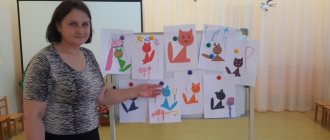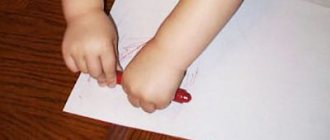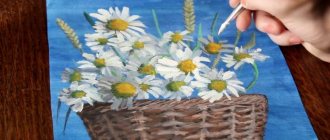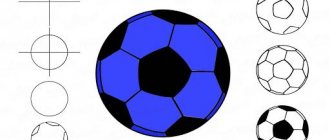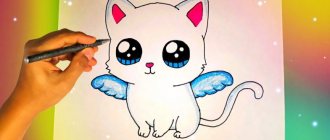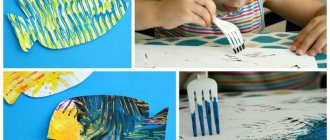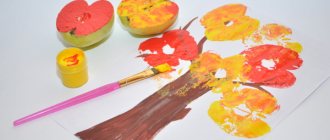Didactic games in fine arts in the younger group
Let's consider what classes in fine arts can be taught to pupils aged 2-3 years. Making each game presented with your own hands using fine art is as easy as shelling pears.
Choose a color for the item
Prepare 6 sheets of colored paper. Find images of 6 objects that match in color. Cut out the objects according to the shape so that when you apply the image to the paper, each object acquires the desired color:
- tomato – red;
- carrot – orange;
- lemon – yellow;
- apple – green;
- flower – blue;
- eggplant – purple.
Cockerel
Draw a cockerel using 5-7 colors. Prepare a palette - small squares of different colors, including those that are present in the colors of the bird. The children's task is to find squares that match the color of the cockerel.
Assemble the pattern
Create simple patterns from geometric shapes and floral elements. Cut out shapes of similar colors and shapes separately. Let the children assemble the pattern according to the sample.
Choose by color
The game is designed to reinforce the names of the main colors. Children activate self-control when perceiving colors.
Take a box containing at least 10 colored pencils. Show the students each pencil in turn, asking them to name objects of a similar color located in the room or outside the window.
Make up a picture
There are visual and didactic games that develop intelligence, the ability to concentrate, compare, and analyze.
Find pictures that clearly depict vegetables and fruits, cut them into 4-6 parts. Invite the children to reconstruct the image.
Balloons
Cut out circles and ovals - the base of the balloons. Make strips separately - these will be the strings for the balls. Lay out the blanks on the table. Ask your child to match the balls with strings of a similar color.
Match the saucer to the cup
The game not only develops the skill of distinguishing shades of the palette, but also develops concentration and motor skills of the fingers.
Prepare a canvas that imitates store shelves, make dishes of different colors from cardboard. Tell the children that the saucers were brought to the store first, then the cups. Vendors need help arranging dishes correctly. The players' task is to choose the right saucers for the cups.
Unusual picture
The game develops imagination in younger preschoolers.
Place a wide plate on the table in front of each student and sprinkle with semolina. Explain that semolina is not only tasty, it is so fine and crumbly that you can use it to create beautiful pictures by drawing with your finger.
Pick up red items
For the game, prepare various small objects (or cards representing them). Dress the doll in a red dress. Tell the students that a girl Masha came to them and asks them to help her choose items of the same color to go with her red outfit. Children take turns taking cards and saying whether the depicted object can be red. If yes, put the picture in Masha's doll's purse.
Classics in an unconventional interpretation
Let's put away the stamps and salt, wipe off our paint-stained pens, and get out the watercolors and brushes. Boring? It’s not boring at all, but very interesting, because with the help of classic watercolor paints we will create miracles!
You need to take thick paper (the best option is special watercolor paper) and wet it until it is sufficiently wet. Put a little paint on the brush and lightly touch the brush to the wet paper. The movements should be light and smooth, the beauty of the result depends on this. Before your eyes, a drop of paint spreads in different directions, turning into something amazing! It's a good time to tell your child about the rules for getting new colors and shades. Now this practice is most obvious. The resulting unimaginable divorces will serve as an interesting backdrop for future creative works.
The next unconventional drawing technique that we will consider, also from the category of “miracles nearby”, is called “Aquatype”.
This is a technique of painting with paints and water, also known as water printing. Just as in the previous method, we will need thick paper, we will choose no less traditional paints - gouache, we also need black or any dark ink. Think with your child, what would he like to portray? This method produces unusually beautiful flowers. After the paints have dried, paint over the entire sheet of paper with ink, then immerse your work in a bowl of water and enjoy the wonderful transformations! The gouache will all dissolve, leaving only your drawing on a dark background. Why isn't it magic?
The series of incredible transformations is not over! Let's take the same thick paper and use wax crayons (if you don't have them at hand, you can use an ordinary candle) apply a drawing or pattern. Next, apply watercolor paint to the entire sheet (the areas treated with wax will not be painted). A drawing will appear on a colored watercolor background, which will be a surprise for the baby, because when you draw with colorless chalk on a white sheet, it is quite difficult to imagine the end result. The process of magic can also ultimately bring quite a practical result.
Making “marble paper” is an extremely exciting activity that kids really like: it’s fun to play with things that are not allowed to be taken at all. For example, dad's shaving foam. To work you will need:
- shaving foam;
- watercolor paints;
- flat plate;
- sheet of thick paper.
First you need to get a saturated solution: mix the paint with water. Then apply a thick layer of shaving foam to the plate, and add a few bright drops of paint in a chaotic manner. Using a brush, we paint drops of paint on the foam, creating intricate zigzags and patterns. Here it is - a magical mystery that will completely absorb an enthusiastic child. And here is the promised practical effect. We apply the sheet to the rainbow foam, and then turn it over so that the foam is on top of the sheet. We remove the remaining foam on the paper with a scraper. And - lo and behold! Unimaginable stains appear from under the foam, similar to a marble pattern. The paper has absorbed the paint. After drying, “marble paper” can be used in making crafts or as an addition to decoration.
Didactic games in fine arts in the middle group
For older children, offer games to develop color vision and imagination, the ability to understand the mood of a picture, compose figures and patterns in compliance with symmetry and spatial relationships.
Cheerful caterpillar
Make circles in different shades. Tasks for children - to make caterpillars from circles in different variations:
- from dark to light shades;
- from cold to warm.
Colorful arithmetic
The circles used for the previous game can be used for another activity that develops color perception. Additionally, draw arithmetic signs: plus, minus, equal. Make the circles in different ways, and the students must guess what shade they will get.
For example:
- red + yellow = orange;
- green – yellow = blue;
- blue + white = light blue.
Palette
Paint the seasons using 4 separate palettes. Place landscapes (autumn, winter, spring, summer) in front of the students. Showcase the palettes you used. The task is to determine by the combination of colors what palette each landscape was painted with.
Bunny
The game develops imagination. Children learn schematic representations of living beings.
For this lesson you will need ovals of different sizes and elongations cut out of cardboard. Invite the players to create a bunny standing on its hind legs from the available figures. If desired, let the children try to place other animals.
Decorate your mitten
The game teaches how to create patterns taking into account spatial relationships and symmetry. Place a mitten cut out of paper and a set of geometric shapes in front of your child. The task is to create a beautiful and symmetrical pattern.
Playing in visual arts can instill the skill of cooperation and interaction. To do this, divide the kindergarteners into pairs and distribute mittens: one with the right one, the other with the left. Let them try to make the same patterns.
Plasticine vase
Let the child connect 2-3 small pieces of plasticine of different shades and knead them well to obtain streaks reminiscent of marble. From the resulting mass he will fashion a vase.
Magic palette
The game develops the perception of the colors of the surrounding world and an emotional response to the beauty of nature.
Give participants square colored cards. Name a natural object. Children must remember how it is colored and pick up the corresponding cards. For example, with the word “birch”, white, black, green squares should be raised. When you hear the word “chamomile” – yellow, white, green. The participant who picks up the wrong card is eliminated.
Painted horses
The game reinforces the idea of the main types of Russian folk paintings.
Prepare painted horses and images of four pastures called “Gzhel”, “Dymka”, “Gorodets”, “Filimonovo”. The child must say what painting each figurine is decorated with and place it in the corresponding pasture.
Artistic constructor
Distribute pencils and sheets of paper with outlines of simple shapes to the students. Offer to complete the images to create recognizable objects.
The role of using non-traditional drawing techniques in the artistic development of preschool children
As mentioned above, the use of non-traditional drawing in kindergarten is beneficial for children. Due to the fact that completely atypical objects can be used in drawing, preschool children are given the opportunity to think outside the box. It turns out that they are having fun and usefully spending their time. They experiment with different painting techniques and try different ways of expressing themselves. Classes develop observation skills, creativity, and artistic taste. The educational process turns into a fun game. Therefore, modern methods of creative activities are increasingly being used in kindergartens. Diagnostics of the use of non-traditional drawing methods in kindergartens shows good results.
Unconventional spray painting technique
Non-standard methods of drawing are always fun, emotional and creative. The result of such creativity is beautiful and unusual, even if the child has no artistic skills.
Didactic games in fine arts in the senior group
In classes with older preschoolers, it is worth paying attention to the emotional side of fine art, developing an understanding of the genres of painting, and developing the skill of constructing a composition.
Draw a portrait
To play, draw 4-5 portraits depicting human emotions: joy, fear, surprise, sadness, anger. Cut the images into 3 parts: forehead and eyes, nose, mouth and chin. For clarity, show several famous painting portraits. Explain what genre this is. Invite participants to become artists and create portraits with different emotions from parts of the face.
Make up a landscape
Place cards on the table depicting various objects of the surrounding world. Ask to choose those from which you can make a landscape.
Collect a still life
Cut out pictures of fruits, vegetables, berries, flowers, mushrooms, vases, baskets, jugs. Ask the children to create a beautiful still life.
Happy or sad
Like the didactic game “Artist,” this activity teaches you to correlate mood with palette.
As visual material, use realistic illustrations from books and reproductions of famous paintings. Show the image to your students and ask them to determine what mood it conveys and why. Children should explain that fun is reflected in bright, rich, light colors, and sadness is reflected in dull, dark, dull colors.
Sea
The game teaches you how to build an artistic composition and develops logical thinking.
Prepare a picture of an empty sea with a background of seaweed and a sandy bottom. Separately depict underwater inhabitants: fish, snails, shells, dolphin, whale, seahorse and others. Explain to the participants that the sea inhabitants hid. To see them, you need to solve riddles. A child who correctly guesses a living creature attaches its picture to the underwater landscape.
What will happen?
Place a piece of paper and pencils in front of the players. Children take turns drawing. One draws a line and gives the sheet to the other participant. He continues the drawing with the second line and passes the baton. And so on until the drawing is ready. At the end, everyone looks at what happened.
What doesn't happen?
Offer kindergarteners a game to develop their imagination. Let them draw something that does not exist. Each participant demonstrates his creation and explains what he depicted. The others discuss whether there really is no such object in the world.
Monotype technique
For older children, you can offer more interesting types of artistic creativity. For example, an interesting technique, which is also based on prints, is “Monotype”. Its goal is to create a symmetrical drawing, such as a mushroom, an insect (butterfly or ladybug); for the senior preschool group, you can depict a landscape reflected in a lake.
We take a landscape sheet of paper, bend it in half, then unfold it and draw on one half relative to the fold line. Since we have agreed to depict a butterfly, we draw one wing, then stroke the folded sheet with our hand. Let's open it - the butterfly already has two wings and they are exactly the same! The missing elements can be completed with a brush.
A feeling of delight is guaranteed, while the child understands that his “hooligan” actions, when blots and splashes fly onto the album sheet, are also a form of art. “Blotography” also has the name “Spraying”. Using these techniques you can achieve unusual artistic effects.
Splashing paint, also known as "Spraying". A toothbrush will come to our aid. Gently dip it into the paint and lightly tap it towards you with a pen or pencil. A huge number of small droplets remain on the sheet. Using this unconventional painting technique, you can create a very realistic winter landscape or deep space with many stars. “Blotography” will help the young artist populate the uninhabited planets of space with funny aliens. All you have to do is put more paint on the brush and let it drip onto a sheet of paper, and you get a blot. And now we blow on it, dispersing the rays in different directions. Let's add a pair of eyes to the dried blot, or maybe two pairs, this is an unknown animal, and send it to populate distant worlds!
An interesting texture can be achieved by using a dry brush. Lightly dip a dry wide brush into the gouache and wipe off the excess paint on the jar. We draw with vertical poking movements. The image turns out “shaggy” and “prickly”, in this way Christmas trees and hedgehogs, a field with green grass turn out to be very realistic. In this non-traditional way, you can draw flowers, such as asters, in kindergarten.
Incredible possibilities of ordinary things.
- Bubble.
It turns out that you can not only blow and burst soap bubbles, but you can also draw with them. Dilute a little paint in a glass of soapy water, take a tube and blow bubbles into the glass. Your kids will enjoy doing this trick. Well, there is a lot of bright multi-colored foam, apply a sheet of paper to it, and as soon as bubbles begin to appear, the paper needs to be removed - the colorful pattern is ready!
- Salt.
Don't be surprised, but salt can be used for more than just cooking. An interesting texture will be obtained if you sprinkle the undried drawing with salt, and when the paint dries, just chicken out.
- Sand, beads and various grains are also used to create creative textures. There are several options for using such materials.
- Sprinkle the pre-glued sheet with cereal, sand or beads, and then draw on the textured surface.
- We cover the areas where the design will be depicted with glue.
- Paint and dry the necessary materials in advance, and then decorate the drawing with them.
Didactic games in fine arts in the preparatory group
When preparing kindergarteners for school, it is important to teach them to describe pictures and their feelings from what they see, to show imagination in everyday life, and to be attentive and observant.
Guess the picture
For the game, prepare reproductions of paintings familiar to kindergarteners. Describe each image verbally and let the children guess what it is about. For example: “In a bright room, a girl in a pink jacket is sitting at a table, she has a fruit in her hands” - this is “Girl with Peaches” by Valentin Serov. Or: “A mother bear and three cubs are frolicking on fallen trees in the middle of a pine forest” - this is “Morning in a Pine Forest” by Ivan Shishkin.
Guess by profile
Prepare recognizable contour profiles of fairy-tale characters: Baba Yaga, Kashchei, the Little Humpbacked Horse, the Serpent Gorynych and others. Children must guess who is pictured.
What does the painting smell like?
Show your students reproductions of paintings. Let them imagine what smells they will smell when they suddenly find themselves inside the painting.
How does the picture sound?
The game is similar to the previous one, only here they imagine not by smell, but by hearing. Let the children imagine what sounds they will hear when they are inside the painting.
What do clouds look like?
If the weather and sky conditions permit, take the group for a walk. If not, find beautiful photos of cumulus clouds. Invite students to imagine what they look like. Emphasize that clouds come in different shapes and sizes.
What's missing?
Show the children some reproductions of famous paintings. Cover up any detail in the images. Show the pictures again and ask them to remember which element is hidden.
Portrait of a neighbor
The game teaches you to correctly and correctly describe a person.
Give participants cardboard frames. Let everyone, bringing the frame closer to their neighbor’s face, try to create a verbal portrait of him.
There is no limit to creativity
For children who have already become acquainted with many interesting techniques and have shown their extraordinary creative abilities, we can offer a rather difficult drawing technique - “scratching”.
You need thick paper, you need to color it with wax crayons, preferably bright colors, then cover it with black gouache or ink using a wide brush. If you intend to use gouache, add a little PVA glue so that the dried paint does not crumble. When the ink (or gouache) has dried, the workpiece is ready for further work. Now we take a thin stack (any sharp, non-writing instrument) and start drawing. But this process can only be called painting conditionally, since the top layer of paint is scraped off. Thus, stroke by stroke, a bright wax layer is revealed and projected into the artist’s idea.
Young artists will enjoy the technique of drawing on glass using plasticine.
Choose the design you like, cover it with glass, and use a black felt-tip pen to draw the outlines of the design onto the glass. Then we proceed to fill the contours with soft plasticine, trying not to protrude beyond the edge. The reverse side does not look so neat, but the front side shows a bright and clear picture. Place your work in a frame, and you can use colored cardboard as a background.
There are also a number of non-traditional drawing techniques in kindergarten that children of the middle and senior preschool groups can easily master. For everyday activities, a combination of applique with a classic pattern may be suitable. Pre-cut elements are glued onto a landscape sheet, after which the image is given a finished look using pencils or paints.
One of the accessible and entertaining techniques is “Frontage”.
This type of fine art has been familiar to us since childhood; remember, they hid a coin under a sheet of paper and shaded it with a simple pencil? In the same way, instead of a coin, you can use dry leaves, and shade not with a pencil, but with colored pastels. The drawing will turn out bright and rich.
We have become acquainted with a large number of drawing techniques and have already learned a lot, so why not put our knowledge into practice? Using both traditional and non-traditional painting techniques, any interior items are decorated. Decorative drawing in kindergarten also has an applied nature; a child can already decorate, for example, a pencil stand or a clay vase, or he can please his mother and create a unique pattern on a cutting board. Just remember that for such work you need to choose waterproof paints: acrylic or oil. To make the result last longer, coat the finished craft with varnish.
For interior decoration, the stained glass technique is used.
The essence of the technique is to apply an adhesive contour and fill it with paint. There are many options for performing this technique, but one of the most interesting is to apply a pattern to oilcloth, and after drying, the pattern can be removed from the oilcloth and glued to any surface, for example, glass - there will be a translucent bright picture.
Let's take a closer look at the technique itself.
The ideal option would be to use specialized stained glass paints, but if you don’t have any, you can be smart and make them yourself. Take ordinary gouache and add PVA glue; after drying, the paints have an elastic structure, which will allow you to remove the picture from the film without difficulty. Choose the design you like and draw its outline onto a transparent oilcloth (you can take a regular file or a transparent plastic folder). It is better to make the outline first with a pencil or felt-tip pen, and then outline it either with a ready-made stained glass outline, or with regular PVA glue from a tube with a dispenser. Wait for the outline to dry, then fill in with bright colors. After complete drying, you can peel the design from the film and decorate the intended surface.
You can decorate not only interior items, but also wardrobe items with special fabric paints. This technique is called “Cold Batik”. Invite your child to make a designer painting of an ordinary white T-shirt, only your child will have one, one and only!
- The T-shirt must first be fixed in an embroidery hoop or in a stretcher for painting on canvas.
- Using a pencil and tracing paper, transfer the image of your favorite cartoon character onto fabric.
One of the most important stages of this method is the application of a reserve composition, in other words, a protective contour that will prevent the paint from spreading over the fabric. The contour must be closed to prevent spreading.
- After drying, according to the scheme known to us, we fill the contours with paint.
- Then the drawing must be fixed. Place one sheet of paper under the design and the other on the design and iron it.
This product can be washed, but it is better to wash it by hand in cool water. The unique product is ready.


